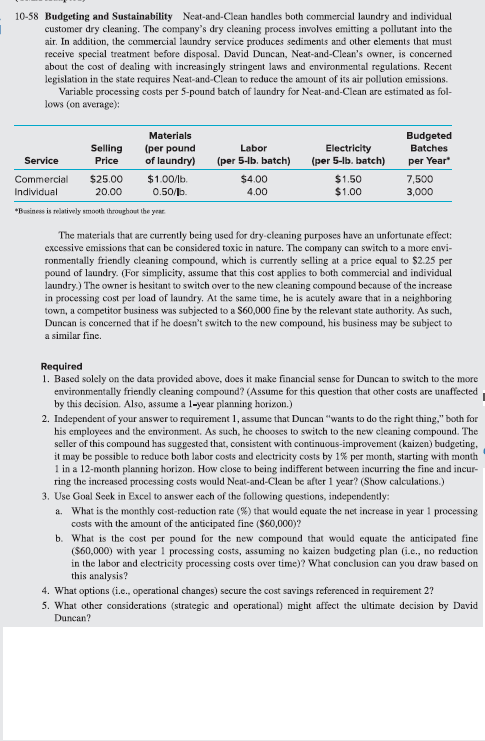
10-58 Budgeting and Sustainability Neat-and-Clean handles both commercial laundry and individual customer dry cleaning. The company's dry cleaning process involves emitting a pollutant into the air. In addition, the commercial laundry service produces sediments and other elements that must receive special treatment before disposal. David Duncan, Neat-and-Clean's owner, is concerned about the cost of dealing with increasingly stringent laws and environmental regulations. Recent legislation in the state requires Neat-and-Clean to reduce the amount of its air pollution emissions. Variable processing costs per 5-pound batch of laundry for Neat-and-Clean are estimated as fol- lows (on average): Budgeted Batches per Year Materials Selling (per pound Service Price of laundry) Commercial $25.00 $1.00/1b Individual 20.00 0.50/6. Business is relatively smooth throughout the year. Labor (per 5-lb. batch) $4.00 4.00 Electricity (per 5-Ib. batch) $1.50 $1.00 7,500 3,000 The materials that are currently being used for dry-cleaning purposes have an unfortunate effect: excessive emissions that can be considered toxic in nature. The company can switch to a more envi- ronmentally friendly cleaning compound, which is currently selling at a price equal to $2.25 per pound of laundry. (For simplicity, assume that this cost applies to both commercial and individual laundry.) The owner is hesitant to switch over to the new cleaning compound because of the increase in processing cost per load of laundry, At the same time, he is acutely aware that in a neighboring town, a competitor business was subjected to a $60,000 fine by the relevant state authority. As such, Duncan is concerned that if he doesn't switch to the new compound, his business may be subject to a similar fine. Required 1. Based solely on the data provided above, does it make financial sense for Duncan to switch to the more environmentally friendly cleaning compound? (Assume for this question that other costs are unaffected by this decision. Also, assume a l-year planning horizon.) 2. Independent of your answer to requirement 1, assume that Duncan "wants to do the right thing," both for his employees and the environment. As such, he chooses to switch to the new cleaning compound. The seller of this compound has suggested that consistent with continuous-improvement (kaizen) budgeting, it may be possible to reduce both labor costs and electricity costs by 1% per month, starting with month 1 in a 12-month planning horizon. How close to being indifferent between incurring the fine and incur- ring the increased processing costs would Neat-and-Clean be after 1 year? (Show calculations.) 3. Use Goal Seek in Excel to answer each of the following questions, independently: 2. What is the monthly cost-reduction rate (%) that would equate the net increase in year 1 processing costs with the amount of the anticipated fine ($60,000)? b. What is the cost per pound for the new compound that would equate the anticipated fine ($60,000) with year 1 processing costs, assuming no kaizen budgeting plan (i.c., no reduction in the labor and electricity processing costs over time)? What conclusion can you draw based on this analysis? 4. What options (i.e., operational changes) secure the cost savings referenced in requirement 2? 5. What other considerations (strategic and operational) might affect the ultimate decision by David Duncan? 10-58 Budgeting and Sustainability Neat-and-Clean handles both commercial laundry and individual customer dry cleaning. The company's dry cleaning process involves emitting a pollutant into the air. In addition, the commercial laundry service produces sediments and other elements that must receive special treatment before disposal. David Duncan, Neat-and-Clean's owner, is concerned about the cost of dealing with increasingly stringent laws and environmental regulations. Recent legislation in the state requires Neat-and-Clean to reduce the amount of its air pollution emissions. Variable processing costs per 5-pound batch of laundry for Neat-and-Clean are estimated as fol- lows (on average): Budgeted Batches per Year Materials Selling (per pound Service Price of laundry) Commercial $25.00 $1.00/1b Individual 20.00 0.50/6. Business is relatively smooth throughout the year. Labor (per 5-lb. batch) $4.00 4.00 Electricity (per 5-Ib. batch) $1.50 $1.00 7,500 3,000 The materials that are currently being used for dry-cleaning purposes have an unfortunate effect: excessive emissions that can be considered toxic in nature. The company can switch to a more envi- ronmentally friendly cleaning compound, which is currently selling at a price equal to $2.25 per pound of laundry. (For simplicity, assume that this cost applies to both commercial and individual laundry.) The owner is hesitant to switch over to the new cleaning compound because of the increase in processing cost per load of laundry, At the same time, he is acutely aware that in a neighboring town, a competitor business was subjected to a $60,000 fine by the relevant state authority. As such, Duncan is concerned that if he doesn't switch to the new compound, his business may be subject to a similar fine. Required 1. Based solely on the data provided above, does it make financial sense for Duncan to switch to the more environmentally friendly cleaning compound? (Assume for this question that other costs are unaffected by this decision. Also, assume a l-year planning horizon.) 2. Independent of your answer to requirement 1, assume that Duncan "wants to do the right thing," both for his employees and the environment. As such, he chooses to switch to the new cleaning compound. The seller of this compound has suggested that consistent with continuous-improvement (kaizen) budgeting, it may be possible to reduce both labor costs and electricity costs by 1% per month, starting with month 1 in a 12-month planning horizon. How close to being indifferent between incurring the fine and incur- ring the increased processing costs would Neat-and-Clean be after 1 year? (Show calculations.) 3. Use Goal Seek in Excel to answer each of the following questions, independently: 2. What is the monthly cost-reduction rate (%) that would equate the net increase in year 1 processing costs with the amount of the anticipated fine ($60,000)? b. What is the cost per pound for the new compound that would equate the anticipated fine ($60,000) with year 1 processing costs, assuming no kaizen budgeting plan (i.c., no reduction in the labor and electricity processing costs over time)? What conclusion can you draw based on this analysis? 4. What options (i.e., operational changes) secure the cost savings referenced in requirement 2? 5. What other considerations (strategic and operational) might affect the ultimate decision by David Duncan







